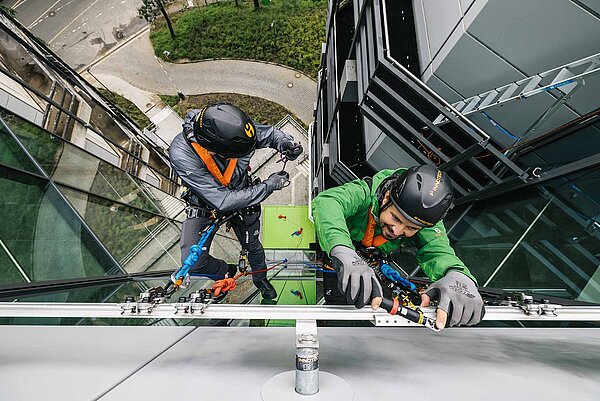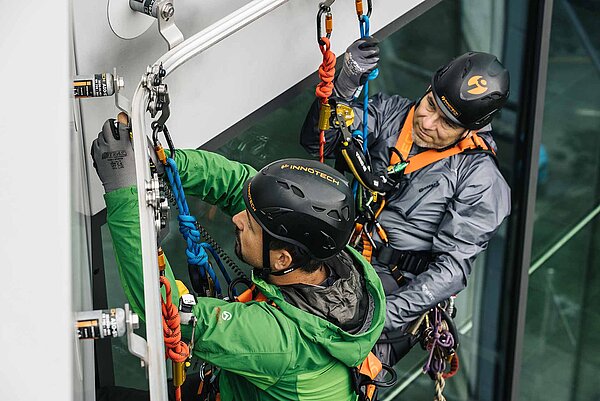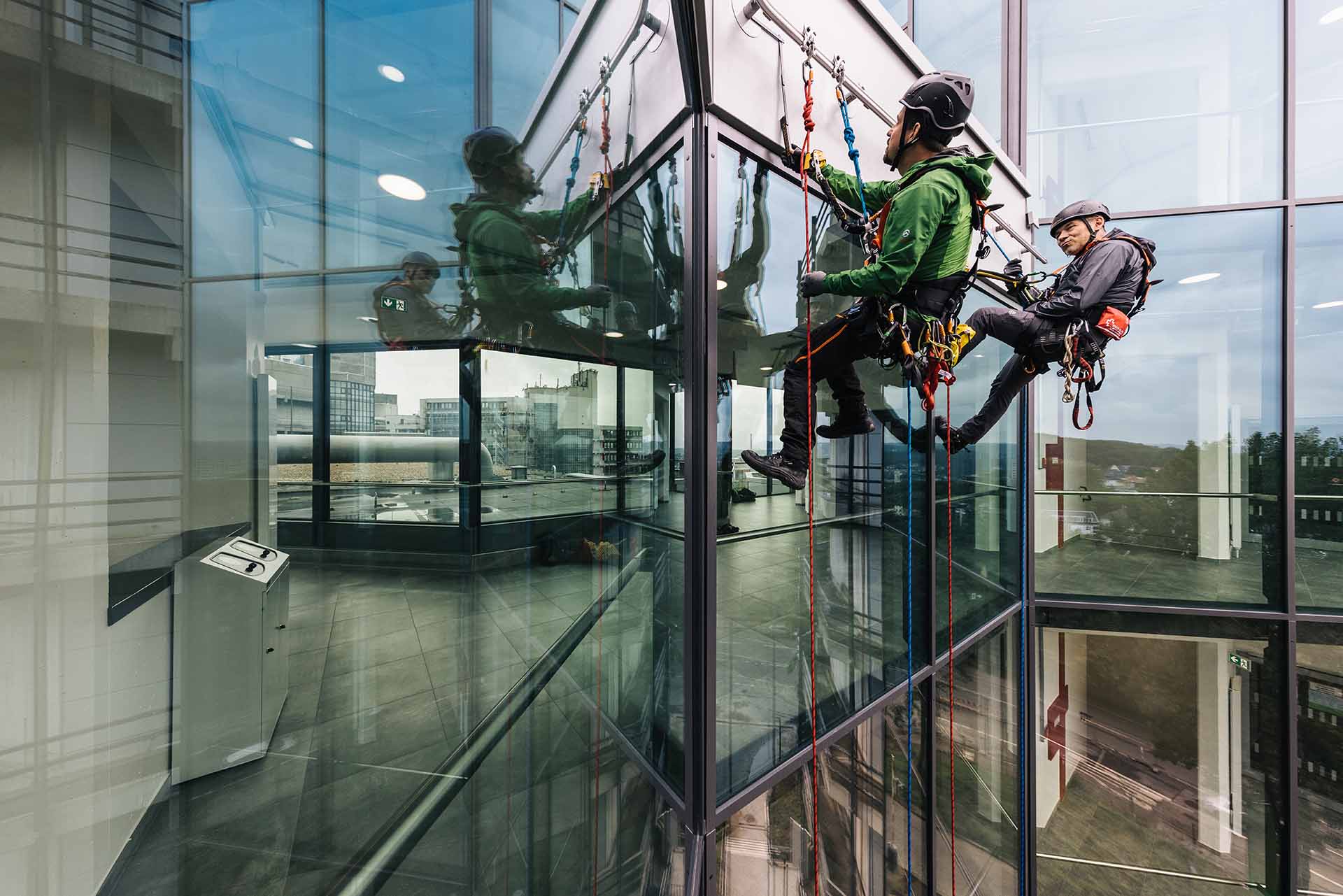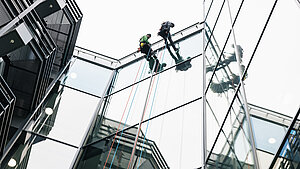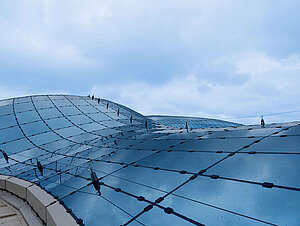Die CEN/TS 16415 is a technical specification from the CEN Technical Committee. It relates to personal fall protection equipment and, more specifically, to anchorage devices. It gives recommendations for anchorage devices which can be used simultaneously by multiple people. This technical specification defines safety requirements and test procedures for ensuring the safety and effectiveness of such equipment.
If the fall protection system for a building structure carries CEN/TS 16415 certification, then it is authorised for use by multiple people. Appropriate specialist knowledge about its use, and compliance with the manufacturer’s instructions, are the prerequisite for use and for reliable fall protection.
Applications
CEN/TS 16415 is of primary importance for manufacturers of anchorage devices, and secondarily for the use of these devices. It relates to anchorage devices which can be used simultaneously by multiple people. CEN/TS 16415 covers the following aspects:
Anchorage devices for multiple users at the same time: This specification is oriented towards anchorage devices which are intended to be used by multiple people simultaneously, for example in situations where servicing or repair tasks on buildings or structures are required.
Exclusion of single-user anchorage devices: CEN/TS 16415 excludes anchorage devices which can be used by only one person individually. These special devices fall under the scope of other standards and specifications.
CEN/TS 16415 relates to standard EN 795 - Personal fall protection equipment - Anchor devices and to standard EN 364 - Personal protective equipment against falls from a height - test methods. If an anchorage device carries CEN/TS 16415 labelling, then it also fulfils the requirements of EN 795.
Requirements and test criteria
The types of anchorage devices are defined in EN 795. CEN/TS 16415 defines the requirements of these types for suitability of use by multiple people. This means that CEN/TS 16415 deals with both fixed and mobile anchorage points, as well as flexible and rigid anchorage guides for fall protection, i.e. cable and rail systems.
CEN/TS 16415 also specifies the respective test criteria for the types. For manufacturers, these are decisive for the product design of anchorage devices. Depending on the type of fall protection equipment, different requirements apply. However, the testing environment can be imagined thus, for example:
- The testing environment is set up according to the type, and the system is loaded accordingly.
- The dynamic strength is also tested.
- For example, a 200 kg load is used to represent 2 people.
- The forces acting are mostly in the 12 k range
The testing setup differs according to the type of anchorage device. For a detailed description, it is recommended to read the currently valid version.
General requirements and overview of static and dynamic testing
As mentioned above, when testing anchorage devices as per CEN/TS 16415, in simple terms one or more weights are suspended from the system. These weights represent the users. The system must of course withstand this load, especially for simultaneous multiple use. These are the requirements in workplaces which must be secured by fall protection equipment and used by multiple people.
The test differentiates between static and dynamic strengths. In general, all types of anchorage devices must pass this load testing.
Insights: Testing of type A and B anchorage devices
Single anchor points - anchorage device type A - are permitted to rotate or swivel, if they are designed to do so. An example of this type is an anchor point for window cleaners. These, as well as temporary safety systems as per anchorage device type B, must withstand the mass or weight in the system, without yielding.

SINGLE ANCHOR POINTS/POSTS
ANCHOR POINTS
SINGLE ANCHOR POINTS/POSTS from INNOTECH are available in very varied models and designs. Depending on substructure and requirement, it is therefore possible to create an optimum solution. Its purpose is to safely dissipate the loads which occur ...

SINGLE ANCHOR POINT/POSTS SET ITEMS
ANCHOR POINTS
SINGLE ANCHOR POINT/POSTS SET ITEMS from INNOTECH are available in very varied models and designs, and they contain all products necessary for secure fastening to the substructure. Depending on substructure and requirement, it is therefore ...

TEMP LIFELINE SYSTEM
TEMP temporary protection
The TEMP lifeline system from INNOTECH can be used everywhere that a horizontal surface must be temporarily protected against falls. The system can be used on construction sites, as well as for industrial structural developments with very varied ...
Insights: Testing of type C and D anchorage devices
What applies to types A and B also applies to permanent anchorage devices with a flexible or a fixed guide: These are anchorage devices types C and D. In addition, for cable or rail systems no part must break - the guides must possess an appropriate minimum break strength, and all individual load-bearing parts must withstand the load. For a cable, a maximum dynamic deflection is also decisive.
Here, a distinction is made between one and multiple fields. This means respectively that either 2 persons hang from one position in the system, and so the load is at a single point (one single field), or else that person/weight A hangs in a section of the safety system equipped with intermediate supports, and person/weight B is in another section (multiple fields). Depending on the structural situation, both cases can arise, and the products must be secured accordingly.

AIO-LIFELINE-SYSTEM-PASSABLE
All-in-one lifeline system, passable
The AIO LIFELINE SYSTEM PASSABLE is used wherever a horizontal surface must be protected. Regardless whether along roofs, facades, in industry or for photovoltaic systems, it provides optimum protection against falls from a height. Neither ...

TAURUS-ALLROUND
Rail system for all-round use
The TAURUS ALLROUND rail system combines the application range and benefits of TAURUS HORIZONTAL and VERTICAL in the form of a flowing transition between horizontal and vertical movement. Regardless whether industrial buildings, architecturally ...

TAURUS-HORIZONTAL
Rail system for horizontal use
The TAURUS HORIZONTAL rail system is used wherever movements along a horizontally running pathway need to be protected from a fall risk. Regardless whether along roofs, facades, for overhead use, in industry or in connection with photovoltaic ...
For a type E anchorage device - system stabilised by intrinsic weight - amongst other things, it is decisive how far the device shifts under load.
Look out for CEN/TS 16415 multi-person test certification
CEN/TS 16415 is an important certification, awarded for multi-person testing of a fall protection system. This certification recognises a fall protection system’s effectiveness and safety for protecting multiple people against potential falls.
The test performed for this certification assesses the system’s performance and reliability in realistic scenarios, and ensures that it fulfils the required standards for fall protection.
If a product has the CEN/TS 16415 seal, this gives users the certainty that appropriate safety is created when the system is used correctly. Users can be sure that it provides the legally specified fall protection and protects multiple people who are working at height.
